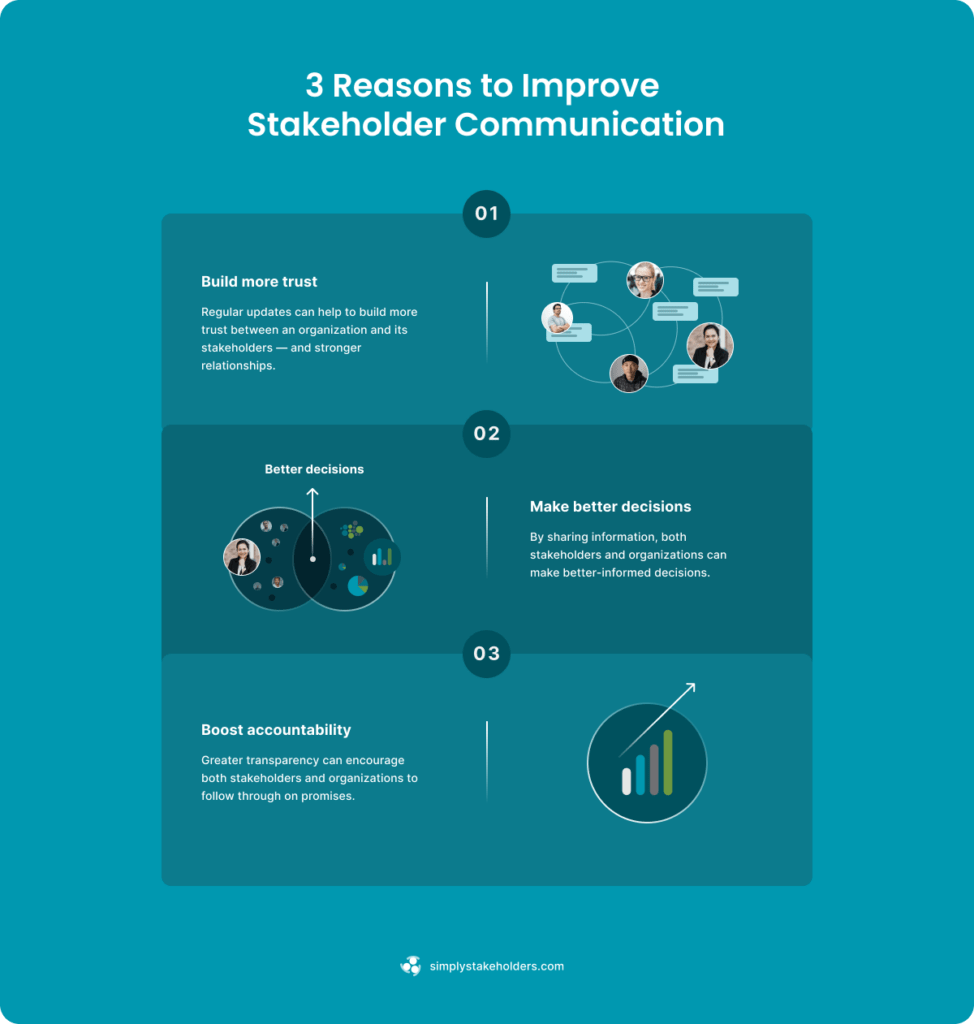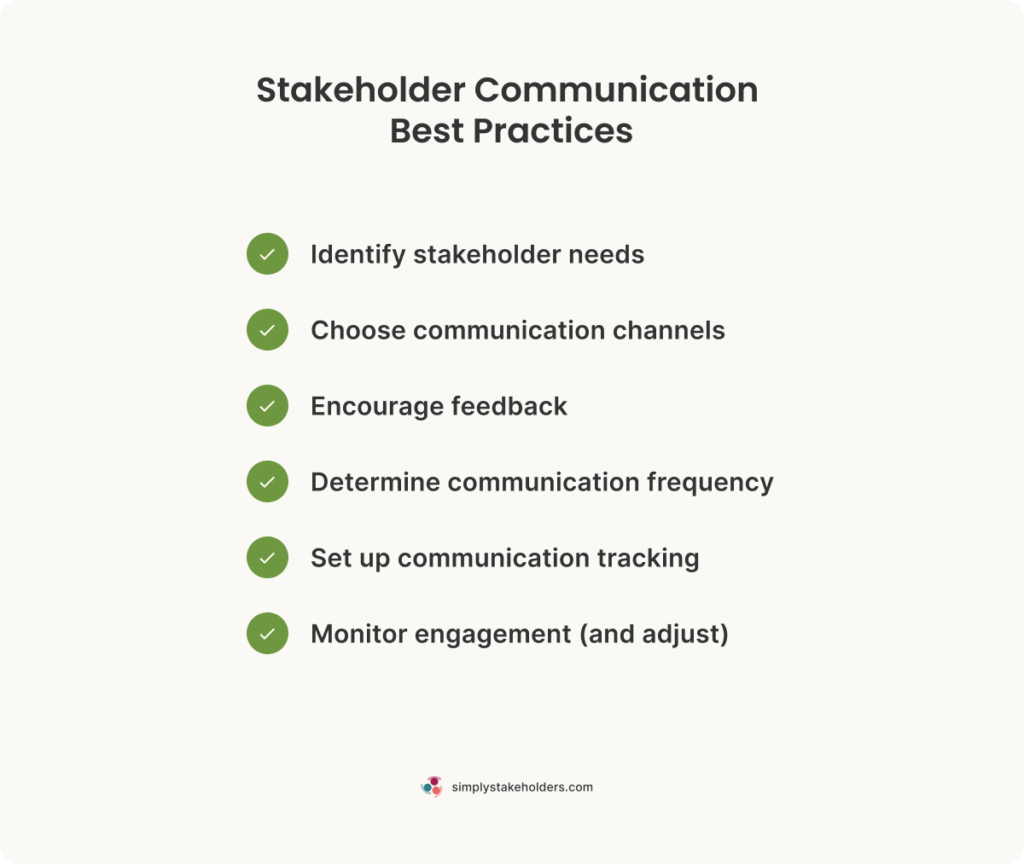Stakeholder Communication: Benefits, Best Practices, and Management

Stakeholder communication is an important skill for every project manager and organizational leader — whether they realize it or not.
Communicating effectively with your stakeholders can make all the difference when it comes to building strategic relationships, increasing your influence, making smarter decisions, and managing risk. On the other hand, if you find yourself dealing with low engagement, greater risk, missed opportunities, damage to your reputation, and even legal issues… poor stakeholder communication may be the culprit.
Ready to build your skills and knowledge in stakeholder communication? We’ve covered all the basics you need to know, along with some advanced tips and best practices to help you improve communication with your stakeholders.
What Is Stakeholder Communication?
Stakeholder communication refers to the methods organizations use to share information and engagement opportunities with stakeholders — the people and groups that are impacted by, have an influence on, or an interest in your project or organization.
It can also refer to the methods stakeholders use to reach an organization with questions, concerns, and feedback.
Common methods of stakeholder communication include:
- Emails
- Letters
- SMS messages
- Reports
- Signage
- Surveys
- Phone calls
- Face-to-face meetings or events
- Online chat messaging
- Social media content
- Blog/news content
Communication is an important part of stakeholder engagement and management, as it enables organizations and stakeholders to share information, manage expectations, and build a shared understanding.
What Are the Benefits of Stakeholder Communication?

Chances are, you already communicate with some of your stakeholders, some of the time. But is it worth putting more resources towards improving your communication, honing your targeting, or reaching a larger stakeholder group? The benefits speak for themselves…
Building Trust
Firstly, stakeholder communication has a key role to play in building trust between an organization and its stakeholders. And trust is key to building strong stakeholder relationships — the kind of relationships that can deliver a lot of value to both parties.
Regular updates can demonstrate that an organization has nothing to hide, and visibility into the project, plans, and performance can help to create transparency and openness.
At the same time, showing up consistently with email updates, letters, and other forms of communication can help stakeholders trust the organization to deliver on their promises and respond to any questions and concerns.
Improving Decision-Making
Regular stakeholder communication can also support better decision-making — for both the organization and its stakeholders.
When you keep stakeholders informed and give them opportunities for two-way communication, their comments can have a genuine impact on your project (especially when you engage them early on in the project). On the other hand, if you only communicate with a small, select group of stakeholders, you risk missing important perspectives on the project, potential roadblocks you’ll need to overcome, and impacts on your project timeline.
For example, you could interview local residents to discover how they might use a proposed new road. But many of the road’s future users will also include families, school communities, and employees who are travelling from other areas. And their input on the project might reveal that in order for the road to be future-proof, it would need several key changes that residents had not mentioned, such as parking, wider areas, and links to an existing transit corridor.
Essentially, the more you know, the better your decisions can be.
Ensuring Accountability
Regular communication between an organization and its stakeholders can also help to improve accountability. This goes both ways — greater transparency and openness can help keep an organization accountable to its values and promises, but it can also keep stakeholders accountable to fulfil their part of the project.
For example, a project manager might need to manage several stakeholders that are involved in a construction project. By keeping in touch with those stakeholders on a daily basis via meetings, phone calls, or messages, they can check on progress, remind people about upcoming milestones, and keep the project moving forward.
Best Practices for Stakeholder Communication

Ready for a more strategic and mature approach to your stakeholder communication? We’ve found that the following best practices can help any organization communicate more effectively with their stakeholders:
Identify Stakeholder Needs
First thing’s first: the better you know your stakeholders, the more effectively you’ll be able to communicate with them. Put yourself in their shoes and consider:
- What sort of communication do they want or need?
- How often might they want to hear from you?
- What are their goals?
- What issues do they care about?
- What do they expect from you?
- What’s relevant to them?
By only sharing relevant information, it’s more likely that your stakeholders will pay attention when they hear from you — and equally, more likely that they’ll respond to your communication.
If you haven’t already, now is a good time to conduct a stakeholder analysis and note down any relevant findings, such as the issues that each stakeholder is concerned about and any specific expectations they may have.
Choose the Right Channels
You can’t talk about stakeholder communication without addressing the elephant in the room — that these days, there are an ever-growing number of channels available for communicating with stakeholders. Most organizations don’t have the resources to communicate and manage responses on every channel. So, it’s important to be selective and choose the right channels.
During your stakeholder analysis, find out where your stakeholders prefer to receive communication, what type of communication they expect to receive on different channels, and how often they’d like to hear from you.
For instance, you might find these communication channels are suitable for the following types of communication:
- Email – Longer-form, regular updates about the project to interested stakeholders who are subscribed to receive updates (learn more about how to write engaging emails)
- SMS – Short updates about an immediate or last-minute event that impacts stakeholders
- Phone calls – Personalised meetings (as needed) to discuss the project with key stakeholders
- Social media content – Short updates or news with information that’s relevant and engaging for a broad range of interested stakeholders (learn more about using social media to engage stakeholders)
- Meetings or events – Presentations with information for key impacted/interested stakeholders, and opportunities to chat and ask questions one-on-one (typically held early on in the project)
- Direct message (e.g. Slack) – Sharing discussions and updates (as things happen) with internal staff and contractors who are involved in or have an influence on the project
In your stakeholder communication plan, note the channels you plan to use and how you plan to use them.
Encourage Feedback
Your stakeholder communication should leave plenty of room for feedback from stakeholders. This means providing multiple ways for stakeholders to get in contact (phone, email, face-to-face, messaging, comments, etc.), along with opportunities to participate in the project or engagement process. It could be as simple as sending out stakeholder surveys to get feedback on your plans, or you may host meetings, focus groups, and events where stakeholders can contribute their ideas and perspectives.
Stakeholder feedback will help you gain valuable insights into your stakeholders and project — as well as insights into how you can improve the engagement as you go (or in future).
Your stakeholders are likely to be busy people and short on time. So encourage them to leave feedback by:
- Engaging in conversation with your stakeholders
- Responding to their questions and comments
- Reporting back on what stakeholder feedback you’ve received
- Demonstrating how it has influenced your decision-making
Establish a Cadence
Consistency is key, and your communication with stakeholders should be regular and predictable. This is important to ensure your stakeholders receive timely updates about the project — and to build confidence that you will continue to show up.
When you’re planning your stakeholder communication, note down how often you plan to communicate via specific channels. It’ll depend on the channels you choose and how you use them, but as a general rule, the following cadence is typical for these channels:
- SMS – As needed for timely notifications or events
- Email – Weekly, fortnightly, or monthly updates
- Letters – Monthly or quarterly updates (or one-off updates)
- Events – Typically concentrated early on in the process, or at major milestones
- Social media – Aim for status updates every day or several times per week
- Phone calls or messages – Typically on an individual and as-needed basis
Once you establish a cadence for each channel, try to stick to it for the duration of the project.
Track All Communication
You should be tracking all your stakeholder communication in your stakeholder system. Depending on your organization and project, this may be a requirement for compliance, demonstrating that you have genuinely engaged with stakeholders. But tracking all the communication that goes out (and the responses you get from stakeholders) is also important to ensure you and your team have context for future stakeholder conversations and engagements, without having to rely on memory.
Having easy access to this past information (and referencing it) will:
- Demonstrate that you’re paying attention
- Help you keep your communication relevant
- Show that you genuinely care about your stakeholders
- Reduce the likelihood of repeating the same information/question twice
- Help you build stronger relationships with stakeholders
If you already have stakeholder relationship management software, make sure you keep an up-to-date record of all emails, messages, and conversation notes inside your software, attached to the relevant contacts.
Monitor Engagement
Finally, it’s important to regularly analyze your stakeholder communication so that you can refine your approach, focus your time on the most effective channels and messages, and apply your learnings to future engagements. Depending on how you’ve been communicating with stakeholders, this could involve looking at the level of engagement/shares on social media, email opens/replies, changes in sentiment over time, and more.
By the way, if you use Simply Stakeholders to manage your stakeholders, our AI-driven sentiment analysis can qualitatively analyze your stakeholder communication to determine how stakeholders feel about an issue!
A Better Way to Manage Stakeholder Communication

Looking for a tool to help improve your stakeholder communication? Simply Stakeholders is designed to simplify stakeholder management with features like contact records, analysis, stakeholder mapping, issues tracking, sentiment analysis, and integrations with communication tools.
Learn more about how it works or reach out to the team if you’d like to see our product in action.



































